The western half of Linnei Township (林內) is a flat mishmash of farmland, industry and residential neighborhoods. Most of the rest shows up on satellite photos as dark green, rugged and hilly.
These woodlands, in the northeastern corner of Yunlin County, are easy to access, even if you’re using public transportation. I wheeled my bicycle off a local train at Linnei, rode south less than 200m, then turned left. According to a bilingual sign on the corner, the distance from there to Longguomai Forest Trail (龍過脈森林步道) is precisely 1,024m.
But it’s a steep 1,024m. I had to shift into low gear before reaching a temple forecourt big enough for half a dozen tour buses. A pair of shrines, one behind the other, face the lowlands. The lower, larger building is Ji Gong Temple (濟公廟). Behind it, and slightly higher up the hillside, is Three Saints Hall (三聖殿).
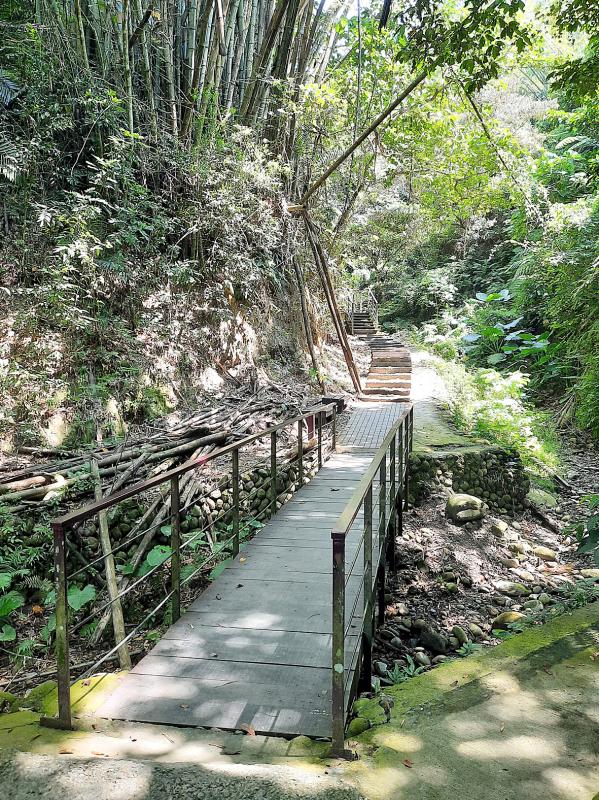
Photo: Steven Crook
THE DRUNK MONK
Ji Gong (濟公) is the name given to a 12th-century Buddhist monk who won respect and admiration during his lifetime for helping the poor and the sick. At the same time, he became notorious for habitually breaking two monastic rules, namely that monks shouldn’t eat meat or drink alcohol.
Sometimes called “the drunk monk,” he’s often portrayed as unkempt and intoxicated. The statue that occupies the central position in Ji Gong Temple depicts the monk as a rakish, Errol Flynn lookalike. A gourd-type bottle dangles from his left hand.
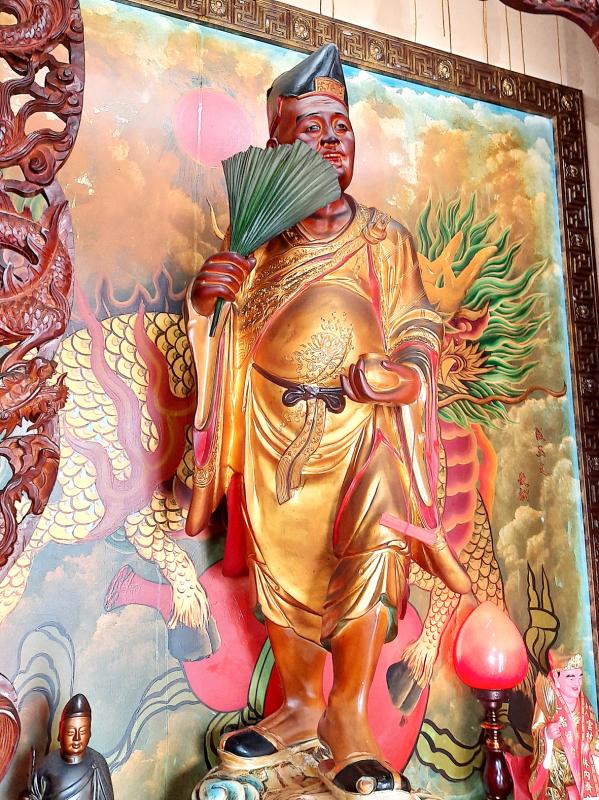
Photo: Steven Crook
Ji Gong also appears in Three Saints Hall, on the right. This version looks suitably sozzled, and even less dependable. Among the offerings on the altar was an opened bottle of Red Label Rice Wine, a clear liquor that non-alcoholics use only for cooking.
As usual, my pre-trip research hadn’t been very thorough. It wasn’t until I wandered around, and gazed down at the torii gate and the stairway that connects Ji Gong Temple with the neighborhood below, that I realized a Shinto shrine had existed here during the period of Japanese colonial rule. Three torii currently stand; I’ve not checked whether any of them are originals.
Leaving my bike locked to a tree 116m above sea level, I set off up Longguomai Forest Trail. I soon came across a detailed mapboard which gave the length of each segment of the path, as well as the altitude at a few different locations.
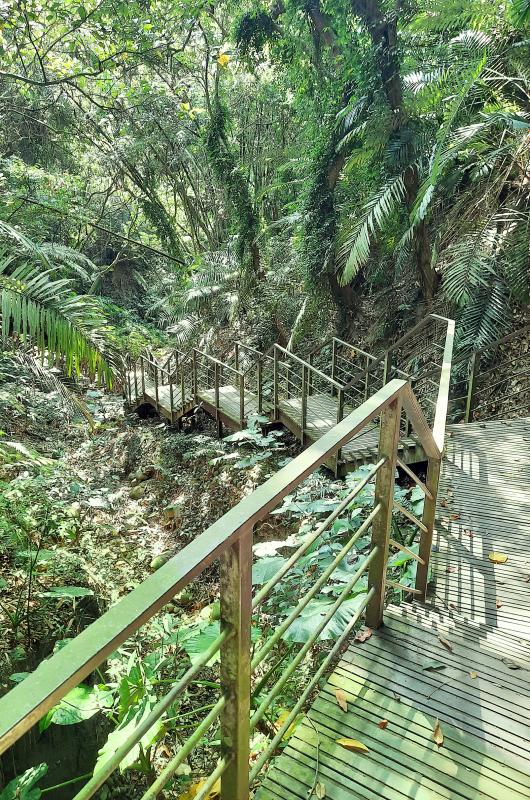
Photo: Steven Crook
From Ji Gong Temple to the eastern end of the trail (elevation: 303m) is just under 2.3km. I spent an hour and a half on the outward journey, including a short detour to a viewing platform, and a cautious look at a path that’s officially closed but which seemed reasonably walkable to me. Because of this alternative route, some sources put the trail network’s total length at 3.4km.
ON THE TRAIL
The canopy around the off-limits track was populated by Formosan macaques. Some Chinese-language blogs warn visitors to Longguomai Forest Trail not to carry food in their hands while hiking, or to have anything hanging from their packs, lest macaques try to grab it. However, the animals I came across all seemed pretty timid. They would glance in my direction, then disappear among the Formosa acacia trees before I got close.
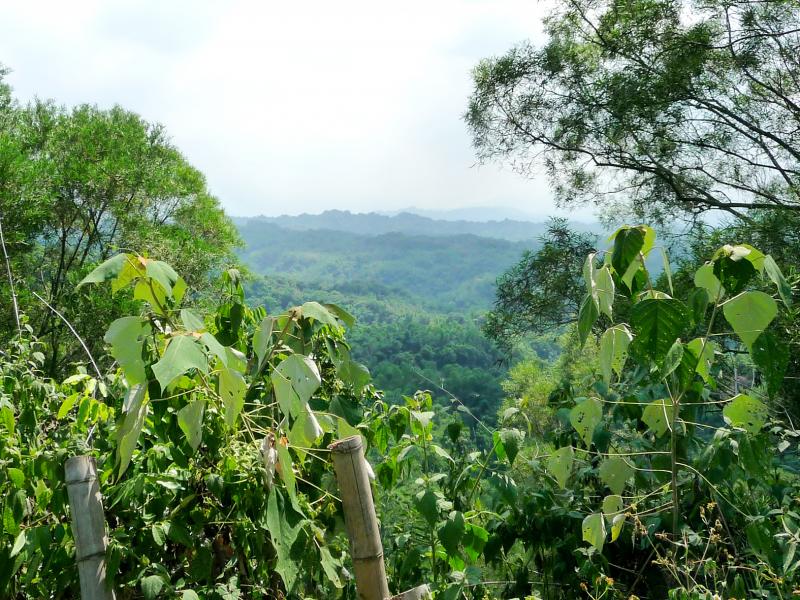
Photo: Steven Crook
The trail’s wooden walkways — raised several inches above the ground, presumably to reduce erosion and not disturb the movement habits of small animals — are linked by stretches of concrete or bare dirt.
Because the sky was a bit murky, the view was unremarkable when I looked toward the sea from the gazebo at the eastern terminus of the trail. Looking north was more interesting, as I could see across the Jhoushui River (濁水溪) as far as the hills behind Ershuei Township (二水).
According to a notice beside the gazebo, the Forestry Bureau’s Nantou District Office will be improving paths and facilities until the end of this year. Yet it’s hard to see what could be done to make the experience much better, apart from a bathroom so people don’t have to backtrack to Ji Gong Temple.
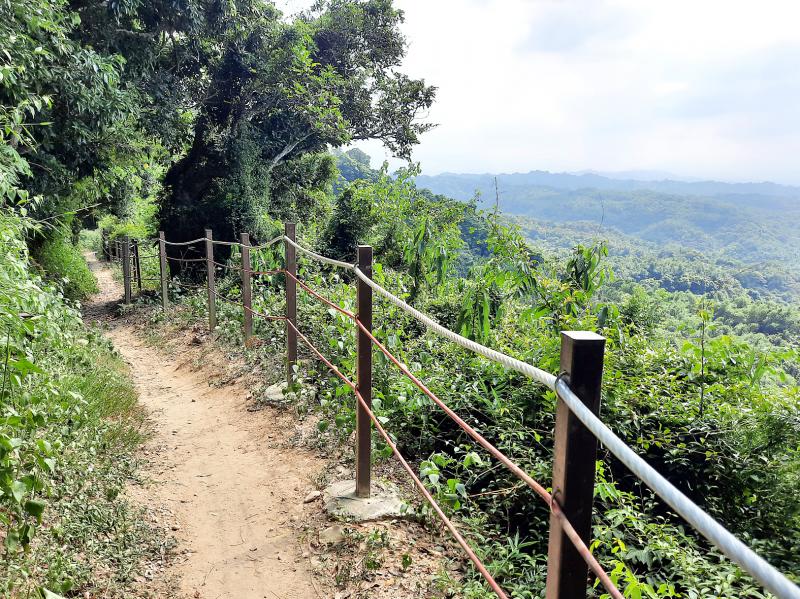
Photo: Steven Crook
Ideally, of course, there’d be fewer mosquitoes. Each time I get bitten, I remind myself that these bloodsuckers play an important role in local ecosystems. They also consume nectar, and when searching for it they pollinate many of the flowers they visit. Also, without mosquitoes, Taiwan would have fewer bats.
Near the closed-off section of trail, a bilingual information board told me a couple of things I didn’t know.
I could see the bamboo there was being farmed for shoots, but I had no idea what species it was (Dendrocalamus latiflorus Munro, a.k.a. Taiwan Giant Bamboo, it so happens). Nor did I know that the mosquito-friendly habitat it creates attracts certain bird species. Mosquito-gobbling Black-naped monarchs and Bronzed drongos are often spotted hereabouts.
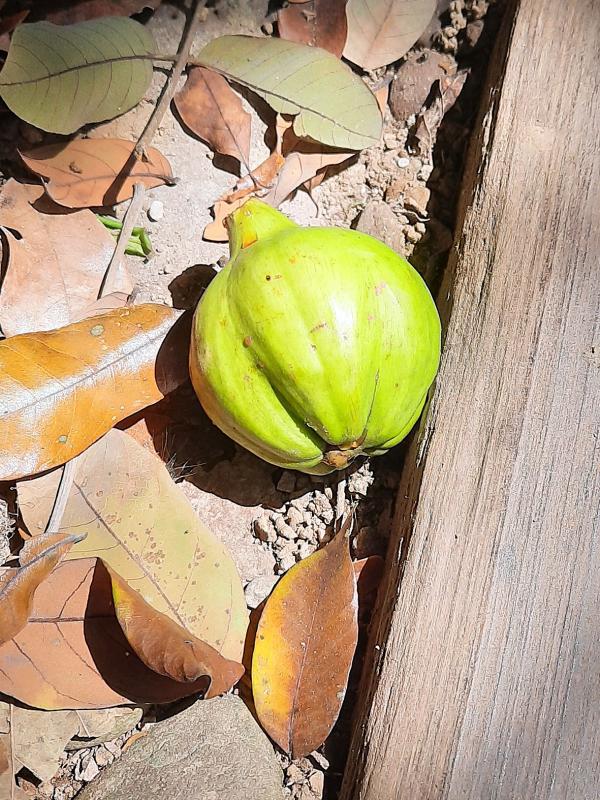
Photo: Steven Crook
The information boards along the trail are generally excellent. However, on one of them, right next to the subtitle “The Cultural Gems of Linnei Township,” a photo of the lowlands draws the reader’s attention to two features: Linnei Incinerator, and a high-voltage transmission tower providing power to the naphtha cracker complex in Mailiao Township (麥寮).
I’ve always thought that Taiwan should make the most of its industrial heritage. Its colonial-era sugar refineries have become tourism and cultural assets. But garbage incinerators and transmission towers? I wasn’t sorry the haze stopped me from seeing everything.
Getting back to my bicycle took just under than 45 minutes, and as soon as I began pedaling, I realized how tired my legs were. In terms of workout for time invested, Longguomai Forest Trail offers rich returns.
Those into butterflies should head for Linnei’s hills in early spring, when every hour thousands of Purple Crow butterflies migrate south to north. Those who find themselves in just the right spot at the right time say it’s a mesmerizing sight.
Steven Crook has been writing about travel, culture and business in Taiwan since 1996. He is the author of Taiwan: The Bradt Travel Guide and co-author of A Culinary History of Taipei: Beyond Pork and Ponlai.

In recent weeks the Trump Administration has been demanding that Taiwan transfer half of its chip manufacturing to the US. In an interview with NewsNation, US Secretary of Commerce Howard Lutnick said that the US would need 50 percent of domestic chip production to protect Taiwan. He stated, discussing Taiwan’s chip production: “My argument to them was, well, if you have 95 percent, how am I gonna get it to protect you? You’re going to put it on a plane? You’re going to put it on a boat?” The stench of the Trump Administration’s mafia-style notions of “protection” was strong

Every now and then, it’s nice to just point somewhere on a map and head out with no plan. In Taiwan, where convenience reigns, food options are plentiful and people are generally friendly and helpful, this type of trip is that much easier to pull off. One day last November, a spur-of-the-moment day hike in the hills of Chiayi County turned into a surprisingly memorable experience that impressed on me once again how fortunate we all are to call this island home. The scenery I walked through that day — a mix of forest and farms reaching up into the clouds

With one week left until election day, the drama is high in the race for the Chinese Nationalist Party (KMT) chair. The race is still potentially wide open between the three frontrunners. The most accurate poll is done by Apollo Survey & Research Co (艾普羅民調公司), which was conducted a week and a half ago with two-thirds of the respondents party members, who are the only ones eligible to vote. For details on the candidates, check the Oct. 4 edition of this column, “A look at the KMT chair candidates” on page 12. The popular frontrunner was 56-year-old Cheng Li-wun (鄭麗文)

“How China Threatens to Force Taiwan Into a Total Blackout” screamed a Wall Street Journal (WSJ) headline last week, yet another of the endless clickbait examples of the energy threat via blockade that doesn’t exist. Since the headline is recycled, I will recycle the rebuttal: once industrial power demand collapses (there’s a blockade so trade is gone, remember?) “a handful of shops and factories could run for months on coal and renewables, as Ko Yun-ling (柯昀伶) and Chao Chia-wei (趙家緯) pointed out in a piece at Taiwan Insight earlier this year.” Sadly, the existence of these facts will not stop the